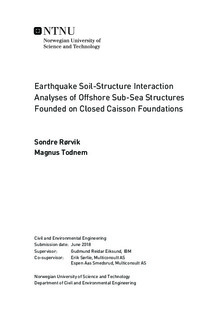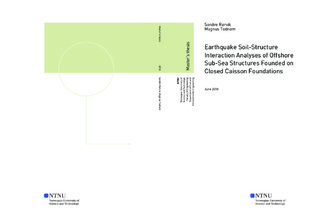| dc.description.abstract | One of the most challenging issues in the design of sub-sea structures founded on closed caisson foundations is their structural response to dynamic loading. Currently, the foundation design is mostly based on fully integrated 3D finite element analyses. There is consensus among market operators that such analyses are too expensive. One of the reasons is the considerable computational time and extensive insight needed by the user. This has induced a major interest in developing more cost-efficient methods for design.
Two of the proposed time-efficient design methods are the simplified modal non-linear analysis method and the simplified time series analysis method. The simplified modal non-linear analysis is developed by Multiconsult AS, and the simplified time series analysis is developed by DNV and Multiconsult AS.
A specific case study is performed to compare the simplified modal non-linear analysis and the simplified time series analysis, in addition to investigating kinematic interaction effects. Only one specific geometry and soil profile is considered in the modelling aspect. For the time series analyses, four different earthquake motions were evaluated.
Time series analyses are conducted in ANSYS Mechanical APDL. The model consists of a beam supported by springs with a module on top. A mass-less rigid link element connects the module to the top of the beam which is situated at seabed level. A site response analysis is conducted in NERA for four different earthquakes, to predict the amplification of seismic waves from bedrock. The time series input from NERA was applied in three different ways, resulting in three different analyses; (1) depth variable time series was applied at each node, (2) the seabed time series was applied at each node and (3) the reference time series from 10 meters depth was applied at each node.
The soil when subjected to cyclic loading, were represented by four bi-linear springs in parallel, to account for the hysteretic damping in the system. These springs were adjusted to follow p-y curves, representing the backbone curve. The p-y curves were calculated using different methods based on slender piles and were scaled to better approximate the response of a rigid, large-diameter caisson. The scaling was done to fit a representative horizontal capacity plot from Plaxis, provided by Multiconsult.
The modal analysis was performed using an in-house developed tool by Multiconsult. This program is based on the simplified modal non-linear analysis. Masses and moments of inertia were taken directly from the ANSYS model, and used in the modal analysis, to have a better foundation for comparison.
Relevant results include moment, shear force, acceleration, displacement and rotation of the structure at seabed level. The modal analysis yielded the highest response of the two methods for all response parameters. From the time series analyses, the seabed input provided the highest response values regarding moment, shear force and accelerations. Depth variable time series input gave the largest displacement and rotations. Reference time series input gave the lowest response values. | |

